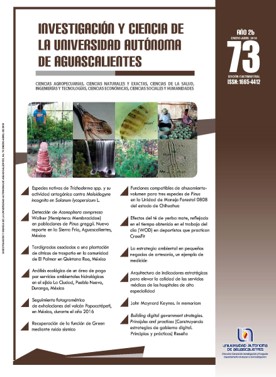Mate tea effects reflected in time performed in the work of the day (WOD) in athletes who practice CrossFit
DOI:
https://doi.org/10.33064/iycuaa201873208Keywords:
mate tea, performance, CrossFit, ergogenic, supplement, resistanceAbstract
Nowadays, the use of nutritional supplements among athletes to improve performance has increased without considering the consequences that may result if not taken properly. However, the natural beverage mate tea is considered as candidate against diseases like obesity because of its multiple benefits, such as: a lower differentiation of adipocytes and triglycerides, an increase in the metabolic rate in addition to its antioxidant and anti-inflammatory function. Benefits in sport performance have not been elucidated yet, which led us to study yerba mate effects in sport performance of CrossFit athletes. Thirty athletes who usually practice CrossFit were evaluated. Mate tea (300 ml) was consumed 30 minutes before the test; performance was evaluated in terms of the total time taken to complete a routine. A positive effect was noted on athletic performance when mate tea was consumed (4:46 minutes vs. 4:13 minutes) p= 0,001.
Downloads
Metrics
References
Alfredo Cabañes, J. J., & Salinero, J. C. (2013). La ingestión de una bebida energética con cafeína mejora la fuerza-resistencia y el rendimiento en escalada deportiva. Archivos de Medicina del Deporte, 30(4), 215-220.
Alkhatib, A. (2014). Yerba Maté (Illex Paraguariensis) ingestion augments fat oxidation and energy expenditure during exercise at various submaximal intensities. Nutrition & Metabolism, 11, 42.
Bastos, D. H. M., De Oliveira, D. M., Matsumoto, R. L. T., Carvalho, P. O., & Ribeiro, M. L. (2007). Yerba maté: Pharmacological properties, research and biotechnology. Medicinal and Aromatic Plant Science and Biotechnology, 1(1), 37-46.
Burke, L., & Deakin, V. (2006). Clinical Sports Nutrition (3rd. ed., pp. 485-580). Sydney-NY: McGraw-Hill.
Crossfitbath. (2017). Blog: WOD19-01-2018 [Fotografía]. Recuperado de http://crossfitbath.com/wod-19-1-18/#iLightbox[gallery10604]/0
Del Coso, J., Muñoz, G., & Muñoz-Guerra, J. (2011). Prevalence of caffeine use in elite athletes following its removal from the World Anti-Doping Agency list of banned substances. Applied Physiology Nutrition,and Metabolism, 36(4), 555-561.
Filip, R., López, P., Giberti, G., Coussio, J., & Ferraro, G. (2001). Phenolic compounds in seven South American Ilex species. Fitoterapia, 72(7), 774-778.
Gambero, A., & Ribeiro, M. L. (2015). The positive effects of yerba maté (Ilex paraguariensis) in obesity. Nutrients, 7(2), 730-750.
Gómez-Juaristi, M., Martínez-López, S., Sarria, B., Bravo, L., & Mateos, R. (2017). Absorption and metabolism of yerba mate phenolic compounds in humans. Food Chemistry, 240, 1028-1038. doi: 10.1016/j.foodchem.2017.08.003
González-Gallego, J., Garrido Pastor, J., Mataix Verdú, J., & Villegas García, J. (1988). Nutrición y ayudas ergogénicas en el deporte. Arch. Medicina del Deporte.
Heck, C. I., & De Mejia, E. G. (2007). Yerba Mate Tea (Ilex paraguariensis):
A comprehensive review on chemistry, health implications, and technological considerations. Journal of Food Science, 72(9), R138-R151.
Kang, Y. R., Lee, H. Y., Kim, J. H., Moon, D. I., Seo, M. Y., Park, S. H.,…Oh, H. G. (2012). Anti-obesity and anti-diabetic effects of Yerba Mate (Ilex paraguariensis) in C57BL/6J mice fed a highfat diet. Laboratory Animal Research, 28(1), 23-29.
Ledon, J. A., & Tosti, A. (2017). CrossFit-associated allergic contact dermatitis. Dermatitis, 28(6), 368. doi: 10.1097/DER.0000000000000321
Maiocchi, M. G., Del Vitto, L. A., Petenatti, M. E., Marchevsky, E. J., Avanza, M. V., Pellerano, R. G., & Petenatti, E. M. (2016). Composición multielemental y valor nutricional de “dumosa” (Ilex dumosa), “yerba mate” (I. paraguariensis) y su mezcla comercial en diferentes formas de uso. FCA UNCUYO, 48(1), 145-159.
Martinet, A., Hostettmann, K., & Schutz, Y. (1999). Thermogenic effects of commercially available plant preparations aimed at treating human obesity. Phytomedicine, 6(4), 231-238.
Myung-Sook , C., Hyo Jin , P., Sang Ryong , K., Do Yeon , K., & Un Ju , J. (2017). Long-term dietary supplementation with yerba mate ameliorates obesity and metabolic disorders in mice by regulating energy expenditure and lipid metabolism. Journal of Medicinal Food, 20(12), 1168-1175.
Poston, W. S., Haddock, C. K., Heinrich, K. M., Jahnke, S. A., Jitnarin, N., & Batchelor, D. B. (2016). Is high-intensity functional training (HIFT)/crossfit safe for military fitness training? Mil Med, 181(7), 627-637.
Sánchez Oliver, A. J., Miranda León, M. T., & Guerra Hernández, E. (septiembre de 2008). Estudio estadístico del consumo de suplementos nutricionales y dietéticos en gimnasios. ALAN Archivos Latinoamericanos de Nutrición, 58(3), 221-227.
Santesteban Moriones, V., & Ibáñez Santos, J. (2017). Ayudas ergogénicas
en el deporte. Nutrición Hospitalaria, 34(1), 204-215.
Schubert, M. M., Astorino, T. A., & Leal Azevedo, J. (2013). The effects of caffeinaited “energy shots” on time trial performance. Nutrients, 5(6), 2062-2075.
Smith, M. M., Sommer, A. J., Starkoff, B. E., & Devor, S. T. (2015). Crossfit-based high-intensity power training improves maximal aerobic fitness and body composition. Journal of Strength and Conditioning Research, 29(10): e1. doi: 10.1519/JSC.0b013e318289e59f
Woolsey, C., Waigandt, A., & Beck, N. C. (2010). Athletes and energy drinks: Reported risk-taking and consequences from the combined use of alcohol and energy drinks. Journal of Applied Sport Psychology, 22(1), 65-71.
Downloads
Published
How to Cite
License
Las obras publicadas en versión electrónica de la revista están bajo la licencia Creative Commons Atribución-NoComercial-CompartirIgual 4.0 Internacional (CC BY-NC-SA 4.0)









